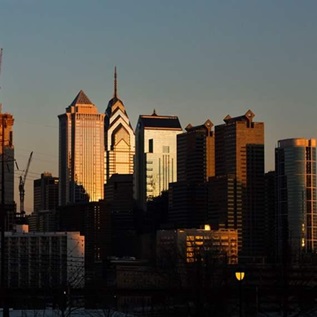Philadelphia Celebrates Restoration and New Lighting of City Hall Tower Statues
The City of Philadelphia will host a public ceremony on Tuesday, December 4 at 6 p.m. on the Municipal Services Building Plaza to rededicate and light the Alexander Milne Calder statues on the City Hall tower: William Penn and the eight sculptural groups of Native Americans, Swedish Settlers, and Eagles.
The colossal bronze statues were erected on the tower between 1894 and 1896 and have withstood the elements for over 100 years. The groundbreaking restoration of the eight sculptural groups of Native Americans, Swedes, and Eagles was completed in February, and the conservation treatment of the William Penn atop the building was completed this month.
“Preserving these treasures for future generations is a responsibility we take seriously” Mayor Street said. “With the new lighting in place, all of our citizens will be able to appreciate the beauty and workmanship of these statues.”
The restoration of the clock-tower sculptures was made possible by the City of Philadelphia, The Pew Charitable Trusts, Save America's Treasures, and the National Endowment for the Arts. Pew's grant also provided funding for a new lighting system to illuminate the eight tower sculptures, as well as an interpretive plaque installed at the north entrance to City Hall. Conservation of the William Penn was funded by the Preservation Alliance for Greater Philadelphia and the City of Philadelphia.
Now that the work is finished, William Penn will once again be illuminated, and the event marks the start of permanent illumination for the other eight sculptures. At the ceremony, Mayor Street will formally turn on the lights to the statues with assistance from Rebecca Rimel, President and CEO of The Pew Charitable Trusts, and John Gallery, Executive Director of the Preservation Alliance of Greater Philadelphia.
City Hall tower is the most widely recognized symbol of Philadelphia for residents and visitors alike. The William Penn stands more than 36 feet tall and weighs over 53,000 pounds. It is the largest sculpture ever to be cast in bronze. It was originally hoisted in thirteen sections by sixteen workmen to its place atop City Hall tower 548 feet above street level. The conservation was performed by Moorland Studios of Stockton, NJ.
The eight tower sculptures consist of four eagles with 15' wingspans and four 24' high figure groups, depicting the Native Americans, Swedish settlers, and eagles. The Tacony Iron and Metal Works of Philadelphia was established to cast these sculptures and the William Penn in bronze. Between the years of 1894-1896, the cast bronze sections of the sculptures were hoisted up into place, bolted together and fastened to the cast iron tower. Chicago conservator Andrzej Dajnowski performed the groundbreaking restoration of these statues.
The Preservation Alliance for greater Philadelphia is a nonprofit membership organization which actively promotes the appreciation, protection, and revitalization of the Philadelphia region's historic buildings, communities, and landscapes.
City of Philadelphia's Public Art Program is responsible for the City's public art collection and is the centralized agency for all public art-related responsibilities including the commissioning, conservation, maintenance and day-to-day management of the public art collection.
The Pew Charitable Trusts is driven by the power of knowledge to solve today's most challenging problems. Pew applies a rigorous, analytical approach to improve public policy, inform the public and stimulate civic life.











